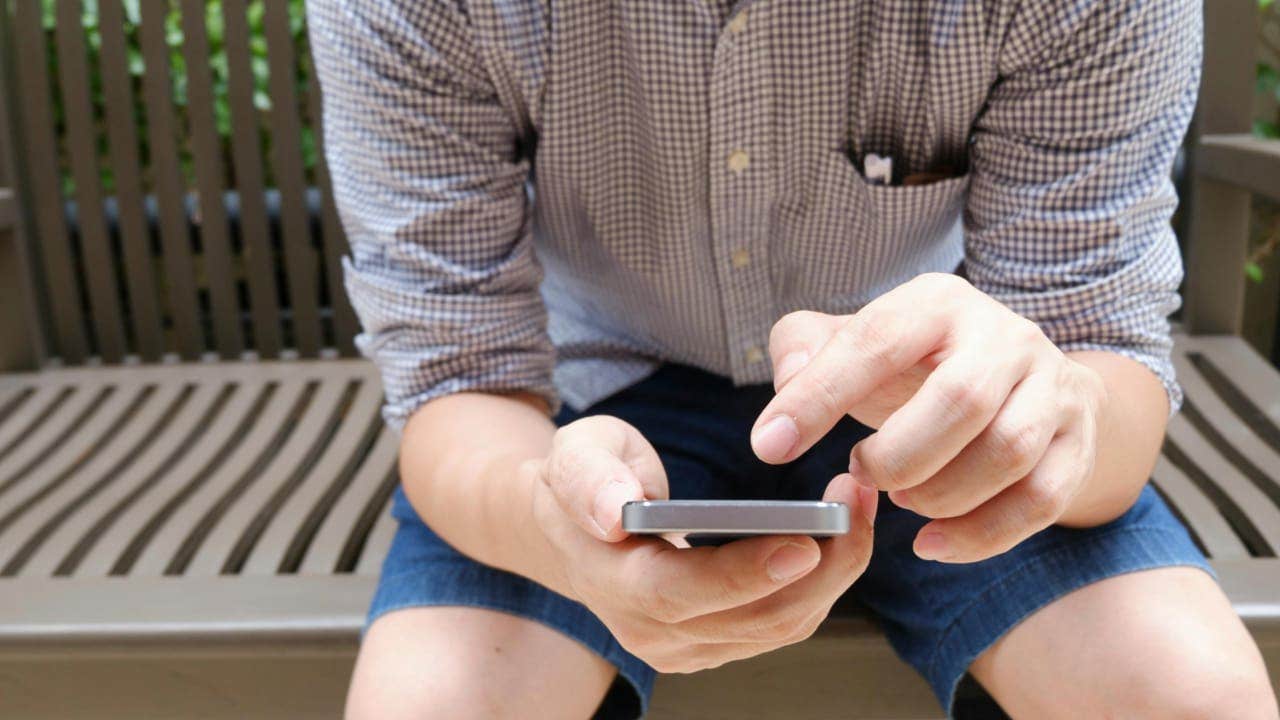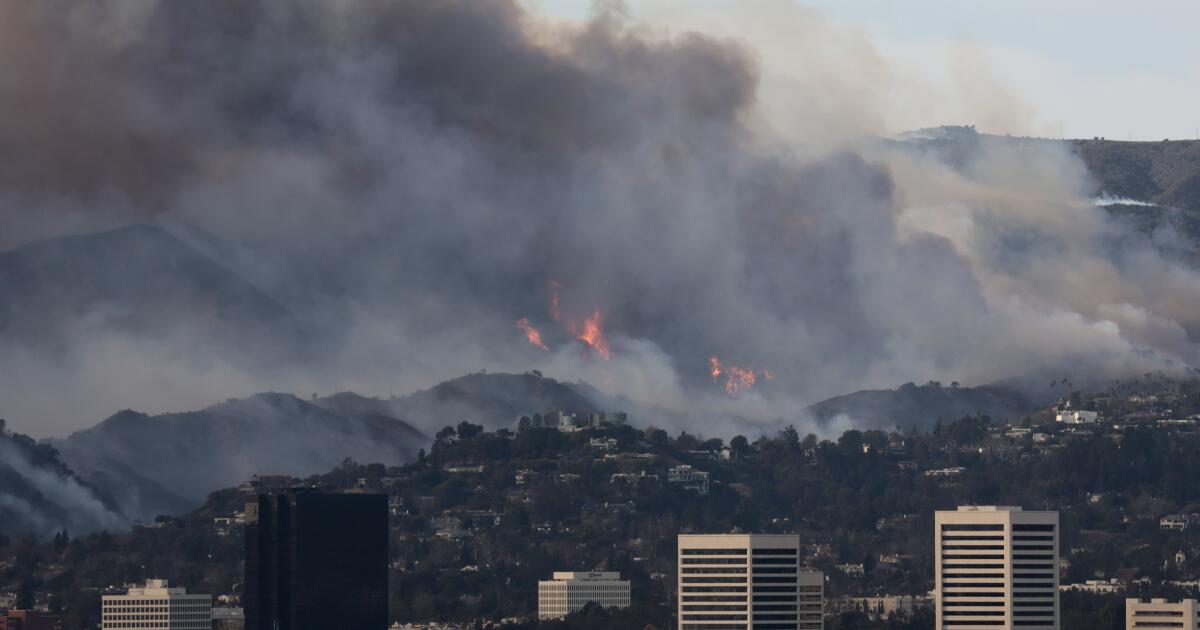Science
These L.A. health teams go door to door with a question: What do you need?
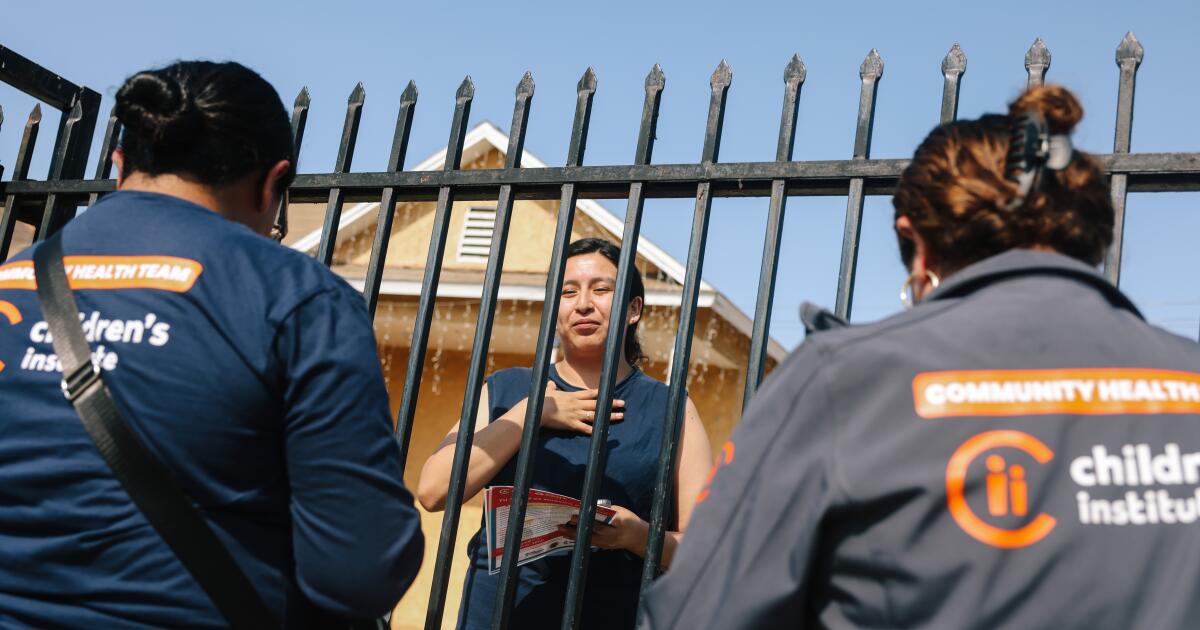
On a sweltering morning in Watts, community health worker Elizabeth Calvillo rapped on a shut gate with her pen, hoping the sound would carry over the rumble of an airplane.
“Good morning! ¡Buenos días!”
When a young mother emerged from the house in her pajamas, shading her eyes from the sun, Calvillo and co-worker Maria Trujillo explained they were knocking on doors to see if she or her neighbors needed anything. They asked the mother: Was she on Medi-Cal? Was there anything else she needed?
The 26-year-old said she had insurance but was tired of spending hours to get seen at a downtown clinic that said it would take months to schedule a physical for her 3-year-old daughter.
“I haven’t even gotten my checkups because it’s so hard to get an appointment,” the woman lamented.
The two promptly offered to refer her to a local clinic. Trujillo put in the referral electronically on the spot. Calvillo told her they would follow up in a week or two to make sure she had gotten an appointment.
The mother thanked them. “I’ve been stressing about it. You guys came at the right time!”
“That’s what we’re here for,” Calvillo replied.
1
2
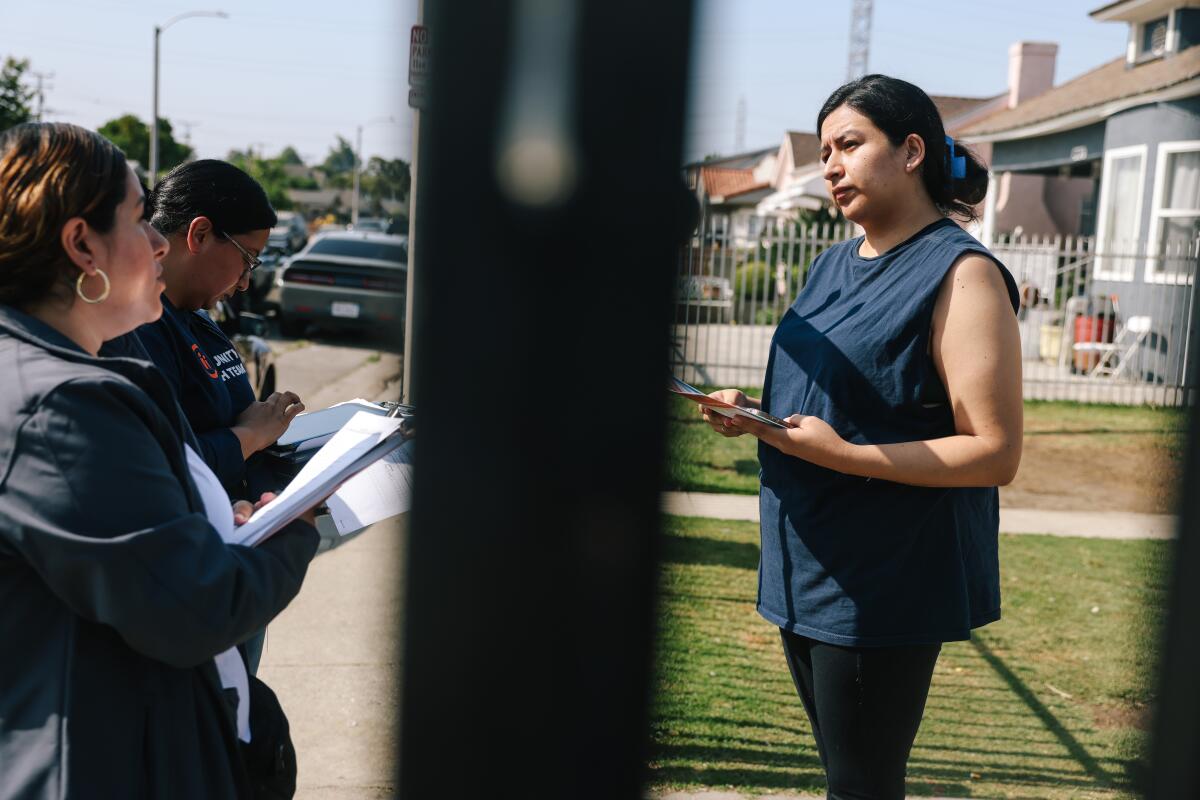
1. Elizabeth Calvillo, left, and Maria Trujillo go door to door in Watts trying to connect people with healthcare and other services. 2. Calvillo, left, and Trujillo speak with Brenda Montes, 26, in Watts on a recent canvassing of the neighborhood. (Dania Maxwell / Los Angeles Times)
In Los Angeles County, the public health department is trying to — quite literally — meet people where they are. This year, it has launched a pilot project that sends teams to knock on doors in neighborhoods like Watts, Pacoima and Lincoln Heights to ask residents what they need.
The county might be able to reach people with billboards or ads, X or Instagram, but knocking on doors is “more personal,” said Trujillo, a community health worker with Children’s Institute, one of the local groups carrying out the work. “You have an actual person coming and showing that they want to be of service to you.”
The Community Public Health Teams, run by community organizations and health groups in partnership with the county, are each tasked with knocking on anywhere from 8,000 to 13,000 doors in designated areas.
Community health workers ask questions for a household assessment — which covers unmet needs for medical care, assistance needed for day-to-day activities, mental health, housing instability, neighborhood violence and other issues — and try to connect people with services such as enrolling in Medi-Cal or finding a food bank. Each team is also linked to a healthcare partner that can offer primary care.
“This is bringing healthcare to the door of the individual,” said Monica Dedhia, director of community health programs for Children’s Institute, “versus waiting for someone to make an appointment.”
The pilot program is expected to last five years, with teams returning at least once a year to check on households. Tiffany Romo, director of the community engagement unit at L.A. County Public Health, likened it to “concierge service.” Even after someone has been linked with healthcare or other needed services, she said, the teams will reach out to them again, making sure they actually got what they needed.
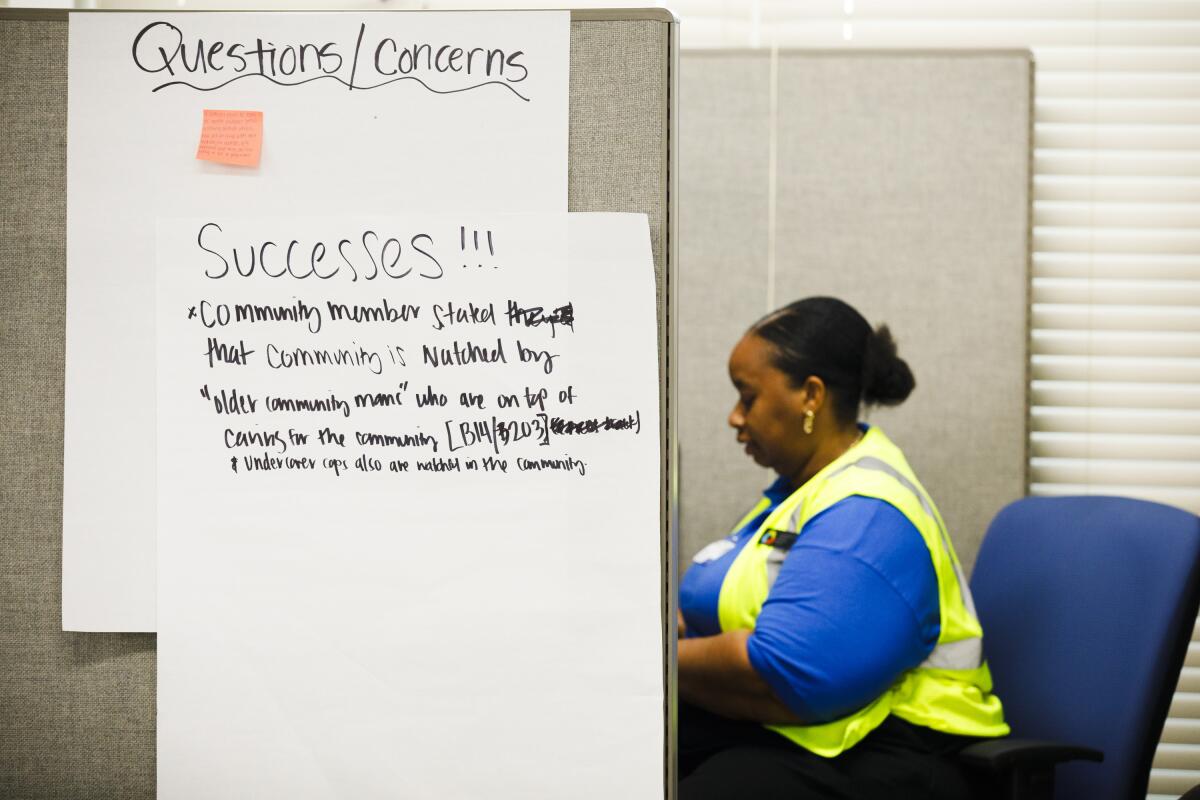
Ashley Jackson works in the Pacoima office of Providence’s Community Public Health Team, where “successes” are listed on a poster.
(Carlin Stiehl / For The Times)
It is a system more common in countries like Costa Rica and Cuba, credited with forging closer connections between health agencies and their communities. Costa Rica, which sends health workers to households, saw a drop in potential years of life lost — one that was sharper for its poorest residents than its wealthiest ones.
But it’s “rarely done in the U.S.” for health workers to be assigned responsibility for the whole population in a geographic area, “including the ones that don’t show up at clinics,” said Dr. Asaf Bitton, associate professor of medicine and healthcare policy at Harvard. “That’s a whole different orientation.”
“We know that most health is created outside the medical care system,” Bitton said, but commercial insurers do not typically pay for things like food or housing. Instead, the approach in the U.S. has largely been, “We will pay for whatever you need once you have the heart attack.”
The pilot program relies on $75 million from a federal grant that will be spread out over five years, providing $1.5 million to each team in 10 “high need” areas.
What success looks like under the program, Romo said, “is really up to the community to define.” But public health officials say their hope is it will drive down inequities and result in healthier neighborhoods. Analyzing the information it gathers will also help inform future efforts at the public health department.
L.A. County Public Health Director Barbara Ferrer said the pilot program emerged not only out of the successes seen in Costa Rica and Cuba, but out of the experiences of the COVID-19 pandemic, when it “became abundantly clear, particularly in lower resource communities, that people were very disconnected from services and support.”
In many cases, “it wasn’t that they were necessarily uninsured or underinsured,” Ferrer said. “They just weren’t connected to a healthcare provider” or other local services. Sometimes the problem was “an information gap,” sometimes fear or distrust and sometimes barriers like long waits or burdensome paperwork, she said.
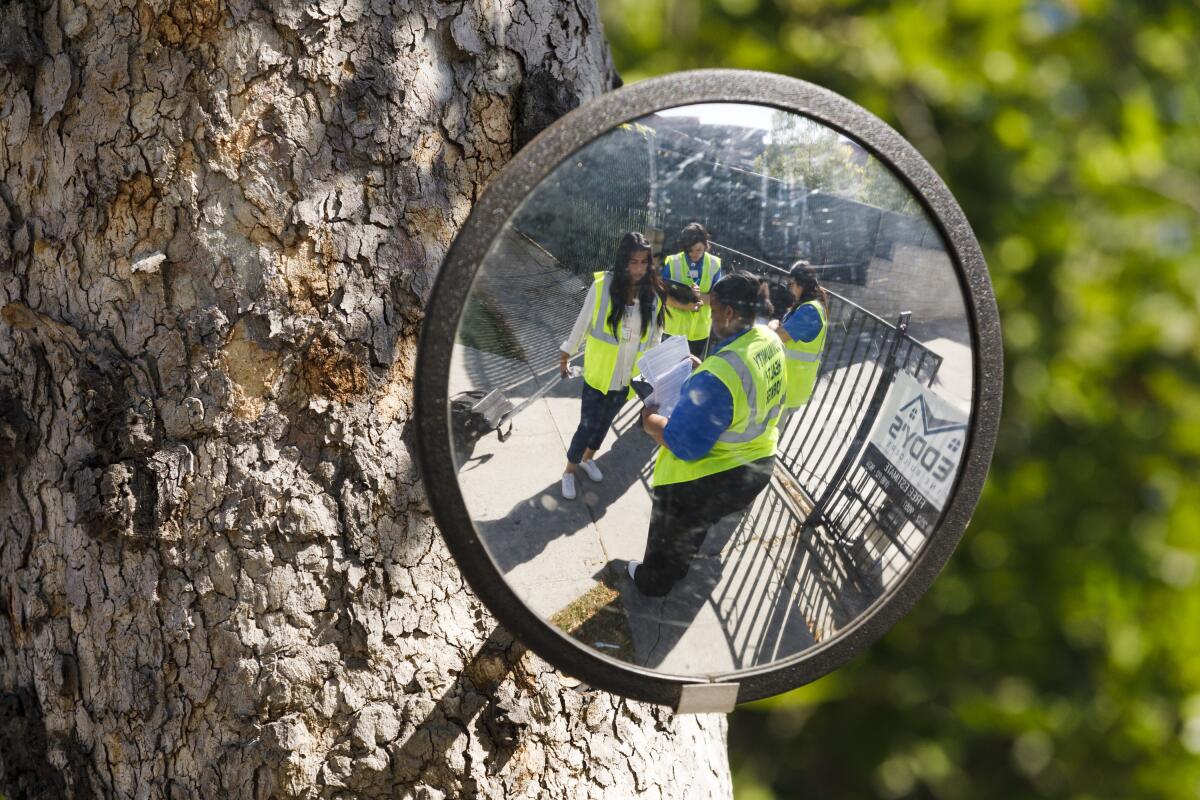
Providence’s Community Public Health Team is reflected in a mirror in Pacoima.
(Carlin Stiehl / For The Times)
In Pacoima, a working-class neighborhood in the San Fernando Valley, many “people just don’t know those resources are available,” said Dionne Zantua, program manager for another team run by Providence Health & Services Foundation.
Scarlett Diaz, a Providence community health worker, said many Pacoima residents also fear that signing up for programs such as Medi-Cal could jeopardize their chances of a green card or citizenship, even as California officials have thrown open the program to eligible residents regardless of immigration status.
Misinformation isn’t the only obstacle: As Diaz and her co-worker Ashley Jackson rounded the neighborhood one Wednesday, clipboards in hand, they faced locked gates and growling dogs. Some residents waved them off or told them to come back another time.
But their daily rounds have made a difference. Before the Providence team in their neon vests stopped at her gate, Monica Avila said she had already seen them walking her Pacoima neighborhood. The 62-year-old tried to hush her barking dogs as Diaz and Jackson began asking about anything she needed.
Avila told them about the speed bumps she wanted the city to install on her block. She told them her husband had died and one of her sons had been killed. That she used to go out dancing, but not anymore.
She told them about the anxiety she suffered, “bad anxiety where like I feel like I’m being locked in,” so bad it was hard to stop by a community center for free resources. Diaz gave Avila her number, offering to help her get what she needed there next time without having to join the crowd inside.
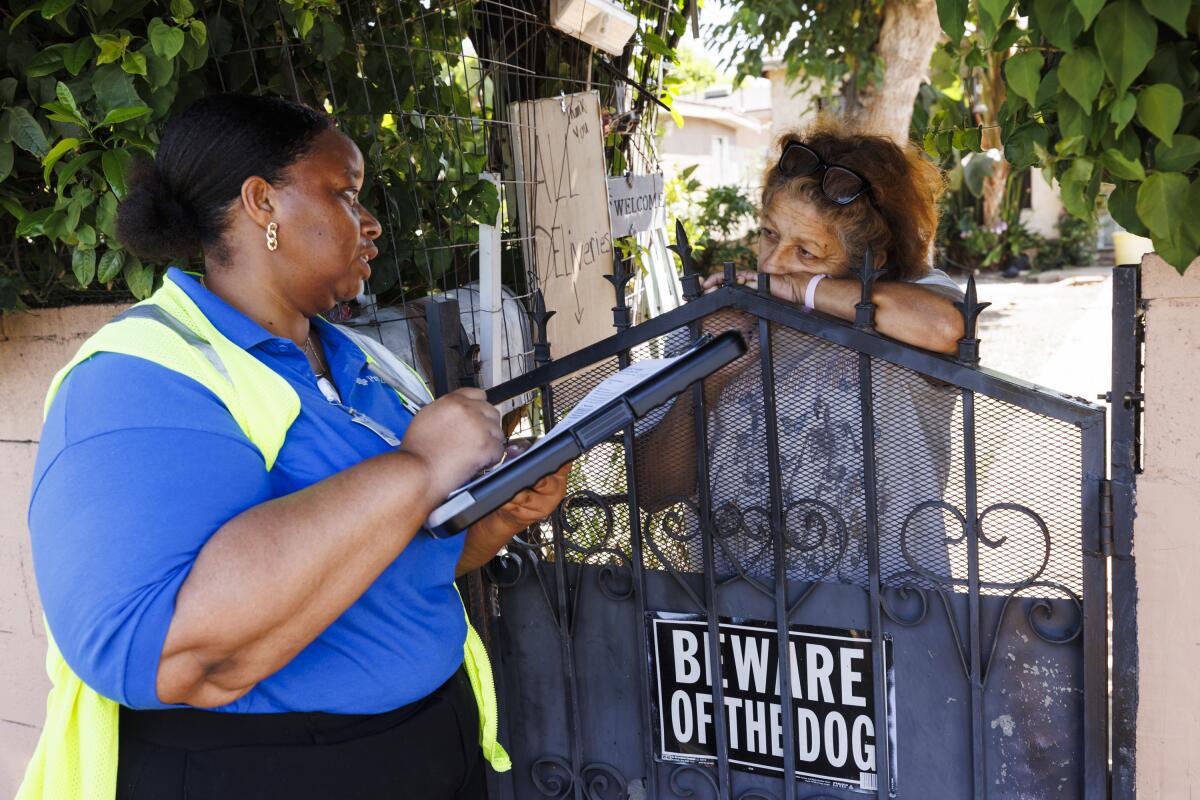
Ashley Jackson of Providence’s Community Public Health Team speaks with Monica Avila in Pacoima last month.
(Carlin Stiehl / For The Times)
Avila seemed relieved. “Thank you for coming and listening to me,” she said.
The work can be slow going: After stopping at more than 40 homes that morning, Jackson and Diaz had ultimately completed two assessments with residents. They left door hangers about the project on fences, planning to return to people they hadn’t reached.
Romo said she expects that a major challenge will be simply getting people to open their doors. Dedhia said that in Watts, for instance, the community “has been heavily surveyed, but the follow-up isn’t necessarily there all the time.” Another community health worker in Watts recalled that at one home, a man grew angry when the team stopped by, asking them, “Isn’t it obvious what the community needs?”
But Ferrer said the program hinges on the fact that “a lot of people have things that they need help with — and they’re not getting help.”
“We’ll build trust very quickly,” she said, “if we can deliver on that.”

Science
How to protect yourself from the smoke caused by L.A. wildfires

You don’t have to live close to a wildfire to be affected by its smoke. With severe winds fanning the fires in and around Pacific Palisades, the Pasadena foothills and Simi Valley, huge swaths of the Southland are contending with dangerous air quality.
Wildfire smoke can irritate your eyes, nose, throat and lungs. The soot may contain all kinds of dangerous pollutants, including some that may cause cancer. The tiniest particles in smoke can travel deep into your lungs or even enter your bloodstream.
Conditions like these aren’t good for anyone, but they’re particularly bad for people in vulnerable groups, including children, those with asthma or other respiratory conditions, people with heart disease and those who are pregnant.
Here’s what you should know to keep yourself safe.
Stay indoors
Minimize your exposure to unhealthy air by staying inside and keeping your doors and windows shut.
If you have a central heating and air conditioning system, you can keep your indoor air clean by turning it on and keeping it running. Make sure the fresh-air intake is closed so that you’re not drawing in outdoor air.
Keep your pets inside
They shouldn’t breathe the unhealthy air either.
Check your air filters
Clean filters work better than dirty ones, and high-efficiency filters work better than regular ones. The California Air Resources Board and the South Coast Air Quality Management District recommend filters with a MERV rating of 13 or higher.
You might consider using portable high-efficiency air cleaner in a room where you spend the most time. The U.S. Environmental Protection Agency has information about them here, and CARB has a list of certified cleaning devices here.
Don’t pollute your indoor air
That means no burning candles or incense. If your power is out and you need to see in the dark, you’re much better off with a flashlight or headlamp.
If you’re cold, bundle up. This is not the time to start a cozy fire in the fireplace. Don’t use a gas stove or wood-fired appliances, since these will make your indoor air quality worse, not better, the AQMD says.
The CDC also advises against vacuuming, since it can stir up dust and release fine particles into the air.
Take care when cleaning up
You don’t want your skin to come into contact with wildfire ash. That means you should wear long sleeves, pants, gloves, socks and shoes. The AQMD even wants you to wear goggles.
If you’re sweeping up ash outdoors, get a hose and mist it with water first. That will keep it from flying up in the air as you move it around. Once the ash is wet, sweep it up gently with a broom or mop. Bag it up in a plastic bag and throw it away.
It’s a good idea to wash your vehicles and outdoor toys if they’re covered in ash. Try not to send ashy water into storm drains. Direct the dirty water into ground areas instead, the AQMD advises.
Those with lung or heart problems should avoid clean-up activities.
Discard spoiled food…
If you lost power for a significant length of time, the food in your refrigerator or freezer may be spoiled.
Food kept in a fridge should stay safe for up to four hours if you’ve kept the door closed. If you’ve been without power for longer than that, you’ll need to toss all perishable items, including meat, poultry, fish, eggs, milk and cut fruits and vegetables. Anything with “an unusual smell, color, or texture” should be thrown out as well, according to the U.S. Centers for Disease and Control Prevention.
Refrigerated medicines should be OK unless the power was out for more than a day. Check the label to make sure.
…even if it was in the freezer
Your freezer may be in better shape, especially if it’s well-stocked. Items in a full freezer may be safe for up to 48 hours if it’s been kept shut, and a half-full freezer may be OK for up to 24 hours. (The frozen items help keep each other cold, so the more the better.)
If items have remained below 40 degrees Fahrenheit (4 degrees Celsius) or you can still see ice crystals in them, they may be OK to use or refreeze, according to the federal government’s food safety website.
Ice cream and frozen yogurt should be thrown out if the power goes out for any amount of time. Meat, poultry, seafood, eggs, milk and most other dairy products need to go if they were exposed to temperatures above 40 degrees F for two hours or longer. The same goes for frozen meals, casseroles, soups, stews and cakes, pies and pastries with custard or cheese fillings.
Fruit and fruit juices that have started to thaw can be refrozen unless they’ve started to get moldy, slimy or smell like yeast. Vegetables and vegetable juices should be discarded if they’ve been above 40 degrees F for six hours or more, even if they look and smell fine.
Breakfast items like waffles and bagels can be refrozen, as can breads, rolls, muffins and other baked goods without custard fillings.
Consider alternative shelter
If you’ve done everything you can but your eyes are still watering, you can’t stop coughing, or you just don’t feel well, seek alternative shelter where the air quality is better.
Hold off on vigorous exercise
Doing anything that would cause you to breathe in more deeply is a bad idea right now.
Mask up outdoors
If you need to be outside for an extended time, be sure to wear a high-quality mask. A surgical mask or cloth mask won’t cut it — health authorities agree that you should reach for an N95 or P-100 respirator with a tight seal.
Are young children at greater risk of wildfire smoke?
Very young children are especially vulnerable to the effects of wildfire smoke because their lungs are still rapidly developing. And because they breathe much faster than adults, they are taking in more toxic particulate matter relative to their tiny bodies, which can trigger inflammation, coughing and wheezing.
Any kind of air pollution can be dangerous to young children, but wildfire smoke is about 10 times as toxic for children compared to air pollution from burning fossil fuels, said Dr. Lisa Patel, clinical associate professor of pediatrics at Stanford Children’s Health. Young children with preexisting respiratory problems like asthma are at even greater risk.
Patel advises parents to keep their young children indoors as much as possible, create a safe room in their home with an air purifier, and try to avoid using gas stoves to avoid polluting the indoor air.
Children over the age of 2 should also wear a well-fitting KN95 mask if they will be outdoors for a long period of time. Infants and toddlers younger than that don’t need to mask up because it can be a suffocation risk, Patel said.
What are the risks for pregnant people?
Pregnant people should also take extra precautions around wildfire smoke, which can cross the placenta and affect a developing fetus. Studies have found that exposure to wildfire smoke during pregnancy can increase the risk of premature birth and low birth weight. Researchers have also linked the toxic chemicals in smoke with maternal health complications including hypertension and preeclampsia.
What about other high-risk populations?
Certain chronic diseases including asthma, chronic obstructive pulmonary disease or other respiratory conditions can also make you particularly vulnerable to wildfire smoke. People with heart disease, diabetes and chronic kidney disease should take extra care to breathe clean air, the CDC says. The tiny particles in wildfire smoke can aggravate existing health problems, and may make heart attacks or strokes more likely, CARB warns.
Get ready for the next emergency
Living in Southern California means another wildfire is coming sooner or later. To prepare for the bad air, you can:
- Stock up on disposable respirators, like N95 or P-100s.
- Have clean filters ready for your A/C system and change them out when things get smoky.
- Know how to check the air quality where you live and work. The AQMD has an interactive map that’s updated hourly. Just type in an address and it will zoom in on the location. You can also sign up to get air quality alerts by email or on your smartphone.
- Know where your fire extinguisher is and keep it handy.
- If you have a heart or lung condition, keep at least five days’ worth of medication on hand.
Times staff writer Karen Garcia contributed to this report.
Science
Punk and Emo Fossils Are a Hot Topic in Paleontology

Mark Sutton, an Imperial College London paleontologist, is not a punk.
“I’m more of a folk and country person,” he said.
But when Dr. Sutton pieced together 3-D renderings of a tiny fossil mollusk, he was struck by the spikes that covered its wormlike body. “This is like a classic punk hairstyle, the way it’s sticking up,” he thought. He called the fossil “Punk.” Then he found a similar fossil with downward-tipped spines reminiscent of long, side-swept “emo” bangs. He nicknamed that specimen after the emotional alt-rock genre.
On Wednesday, Dr. Sutton and his colleagues published a paper in the journal Nature formally naming the creatures as the species Punk ferox and Emo vorticaudum. True to their names, these worm-mollusks are behind something of an upset (if not quite “anarchy in the U.K.”) over scientists’ understanding of the origins of one of the biggest groups of animals on Earth.
In terms of sheer number of species, mollusks are second only to arthropods (the group that contains insects, spiders and crustaceans). The better-known half of the mollusk family tree, conchiferans, contains animals like snails, clams and octopuses. “The other half is this weird and wacky group of spiny things,” Dr. Sutton said. Some animals in this branch, the aculiferans, resemble armored marine slugs, while others are “obscure, weird molluscan worms,” he said.
Punk and Emo, the forerunners of today’s worm-mollusks, lived on the dark seafloor amid gardens of sponges, nearly 200 million years before the first dinosaurs emerged on land. Today, their ancient seafloor is a fossil site at the border between England and Wales.
The site is littered with rounded rocky nodules that “look a bit like potatoes,” Dr. Sutton said. “And then you crack them open, and some of them have got these fossils inside. But the thing is, they don’t really look like much at first.”
While the nodules can preserve an entire animal’s body in 3-D, the cross-section that becomes visible when a nodule is cracked open can be difficult to interpret “because you’re not seeing the full anatomy,” Dr. Sutton said.
Paleontologists can use CT scans to see parts of fossils still hidden in rock, essentially taking thousands of X-rays of the fossil and then stitching those X-ray slices together into one digital 3-D image. But in these nodules, the fossilized creatures and the rock surrounding them are too similar in density to be easily differentiated by X-rays. Instead, Dr. Sutton essentially recreated this process of slicing and imaging by hand.
“We grind away a slice at a time, take a photo, repeat at 20-micron intervals or so, and basically destroy but digitize the fossil as we go,” Dr. Sutton said. At the end of the process, the original fossil nodule is “a sad-looking pile of dust,” but the thousands of images, when painstakingly digitally combined, provide a remarkable picture of the fossil animal.
Punk and Emo’s Hot Topic-worthy spikes set them apart from other fossils from the aculiferan branch of the mollusk family. “We don’t know much about aculiferans, and it’s unusual to find out we’ve suddenly got two,” Dr. Sutton said.
Stewart Edie, the curator of fossil bivalves at the Smithsonian National Museum of Natural History, said that Punk and Emo’s bizarre appearances shook up a long-held understanding of how mollusks evolved. Traditionally, scientists thought that the group of mollusks containing snails, clams and cephalopods “saw all of the evolutionary action,” said Dr. Edie, who was not involved with the new discovery. “And the other major group, the aculiferans, were considerably less adventurous.” But Punk and Emo “buck that trend,” he said.
The new alt-rock aculiferans reveal the hidden diversity of their group in the distant past and raise questions about why their descendants make up such a small part of the mollusk class today. “This is really giving us an almost unprecedented window into the sorts of things that were actually around when mollusks were getting going,” Dr. Sutton said. “It’s just this little weird, unexpected, really clear view of what was going on in the early history of one of the most important groups of animals.”
Science
FDA sets limits for lead in many baby foods as California disclosure law takes effect

The U.S. Food and Drug Administration this week set maximum levels for lead in baby foods such as jarred fruits and vegetables, yogurts and dry cereal, part of an effort to cut young kids’ exposure to the toxic metal that causes developmental and neurological problems.
The agency issued final guidance that it estimated could reduce lead exposure from processed baby foods by about 20% to 30%. The limits are voluntary, not mandatory, for food manufacturers, but they allow the FDA to take enforcement action if foods exceed the levels.
It’s part of the FDA’s ongoing effort to “reduce dietary exposure to contaminants, including lead, in foods to as low as possible over time, while maintaining access to nutritious foods,” the agency said in a statement.
Consumer advocates, who have long sought limits on lead in children’s foods, welcomed the guidance first proposed two years ago, but said it didn’t go far enough.
“FDA’s actions today are a step forward and will help protect children,” said Thomas Galligan, a scientist with the Center for Science in the Public Interest. “However, the agency took too long to act and ignored important public input that could have strengthened these standards.”
The new limits on lead for children younger than 2 don’t cover grain-based snacks such as puffs and teething biscuits, which some research has shown contain higher levels of lead. And they don’t limit other metals such as cadmium that have been detected in baby foods.
The FDA’s announcement comes just one week after a new California law took effect that requires baby food makers selling products in California to provide a QR code on their packaging to take consumers to monthly test results for the presence in their product of four heavy metals: lead, mercury, arsenic and cadmium.
The change, required under a law passed by the California Legislature in 2023, will affect consumers nationwide. Because companies are unlikely to create separate packaging for the California market, QR codes are likely to appear on products sold across the country, and consumers everywhere will be able to view the heavy metal concentrations.
Although companies are required to start printing new packaging and publishing test results of products manufactured beginning in January, it may take time for the products to hit grocery shelves.
The law was inspired by a 2021 congressional investigation that found dangerously high levels of heavy metals in packaged foods marketed for babies and toddlers. Baby foods and their ingredients had up to 91 times the arsenic level, up to 177 times the lead level, up to 69 times the cadmium level, and up to five times the mercury level that the U.S. allows to be present in bottled or drinking water, the investigation found.
There’s no safe level of lead exposure for children, according to the U.S. Centers for Disease Control and Prevention. The metal causes “well-documented health effects,” including brain and nervous system damage and slowed growth and development. However, lead occurs naturally in some foods and comes from pollutants in air, water and soil, which can make it impossible to eliminate entirely.
The FDA guidance sets a lead limit of 10 parts per billion for fruits, most vegetables, grain and meat mixtures, yogurts, custards and puddings and single-ingredient meats. It sets a limit of 20 parts per billion for single-ingredient root vegetables and for dry infant cereals. The guidance covers packaged processed foods sold in jars, pouches, tubs or boxes.
Jaclyn Bowen, executive director of the Clean Label Project, an organization that certifies baby foods as having low levels of toxic substances, said consumers can use the new FDA guidance in tandem with the new California law: The FDA, she said, has provided parents a “hard and fast number” to consider a benchmark when looking at the new monthly test results.
But Brian Ronholm, director of food policy for Consumer Reports, called the FDA limits “virtually meaningless because they’re based more on industry feasibility and not on what would best protect public health.” A product with a lead level of 10 parts per billion is “still too high for baby food. What we’ve heard from a lot of these manufacturers is they are testing well below that number.”
The new FDA guidance comes more than a year after lead-tainted pouches of apple cinnamon puree sickened more than 560 children in the U.S. between October 2023 and April 2024, according to the CDC.
The levels of lead detected in those products were more than 2,000 times higher than the FDA’s maximum. Officials stressed that the agency doesn’t need guidance to take action on foods that violate the law.
Aleccia writes for the Associated Press. Gold reports for The Times’ early childhood education initiative, focusing on the learning and development of California children from birth to age 5. For more information about the initiative and its philanthropic funders, go to latimes.com/earlyed.
-

 Business1 week ago
Business1 week agoThese are the top 7 issues facing the struggling restaurant industry in 2025
-

 Culture1 week ago
Culture1 week agoThe 25 worst losses in college football history, including Baylor’s 2024 entry at Colorado
-

 Sports1 week ago
Sports1 week agoThe top out-of-contract players available as free transfers: Kimmich, De Bruyne, Van Dijk…
-

 Politics7 days ago
Politics7 days agoNew Orleans attacker had 'remote detonator' for explosives in French Quarter, Biden says
-

 Politics6 days ago
Politics6 days agoCarter's judicial picks reshaped the federal bench across the country
-

 Politics5 days ago
Politics5 days agoWho Are the Recipients of the Presidential Medal of Freedom?
-

 Health4 days ago
Health4 days agoOzempic ‘microdosing’ is the new weight-loss trend: Should you try it?
-

 World1 week ago
World1 week agoIvory Coast says French troops to leave country after decades

